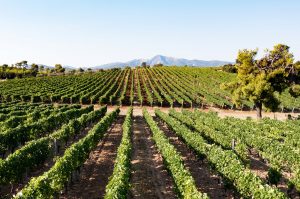Mount Kithairon is the peak that gives name to the mountain range defining the border between the regions of Boeotia, to the north, and Attica, in the south. Composed mainly of limestone and rising up to 1,409 metres, it is a geological treasure, in the heart of central Greece, which shapes a unique landscape – quintessentially Mediterranean yet utterly unique.
A singular wine region
Mount Kithairon is also the home of PGI Slopes of Kithaironas, the geographical indication under which the wines produced from the vines planted on the slopes of Kithairon are labelled. The PGI produces white, red and rosé wines, from a selection of indigenous and international varieties, all incredibly adapted to the local terroir. Altitude, exposition, wide temperature ranges and favourable winds play key roles in the different and characterful expressions of all these grapes that can be found across the PGI Slopes of Kithaironas.
The local climate, Mediterranean with marked continental influences, is particularly conducive to the slow ripening of grapes, retaining vibrant acid while developing a complex aromatic profile. Vineyards are planted at between 300 and 400 metres altitude, benefiting from considerable temperature amplitude, both diurnal (with cold nights, even in summer, offset the day’s sometimes inclement heat) and annual. The region indeed defies stereotypes about Greek terroirs; during winter, vineyards are often covered in snow confirming the continental lineage of the region.
Proud heirs of wine history
Both historiographic and archaeological records confirm viticultural and oenological activity on the slopes of Kithairon as far back as 2,500 BC. Some of the region’s most important archaeological sites – such as the Oracle of Kithaironas, and the caves of Sragidio and of the Dionysus Nymphs – have a deep symbolic meaning, conveying the religious and spiritual role that wine played at the core of Greece’s identity and culture. The ancient city of Eleutherae, located precisely on the border between Attiki and Boeotia, was indeed a worship centre dedicated to Dionysius, god of wine and hedonism.
It shouldn’t come as a surprise, therefore, that viticulture and winemaking are so embedded in the culture and lands of PGI Slopes of Kithaironas. Today, the region produces wines, across a variety of styles, focused on quality and approachability.

White wine production is dominated by local grapes such as Malagousia, Assyrtiko, and Savatiano. These yield fresh and lifted wines, with aromatic intensity balanced by the pleasant acidity levels preserved by the grapes grown on the Slopes of Kithaironas. This same freshness can be seen in the reds, offering drinkability but also intensity of fruit and savoury appeal. Agiogitiko is the main indigenous red variety, with outstanding examples also produced from international counterparts, namely Cabernet Sauvignon, Merlot and Syrah.
The wines are very evocative of the local landscape – after a single sip one is easily transported to the hills of the Kithairon range, enveloped by the earthy smell of the Mediterranean shrub and the delicate fragrance of herbs and wildflowers. A hidden gem, waiting to be discovered.
Discover more about the PGI wines of Attica
Connect on:
Instagram | Facebook | YouTube








